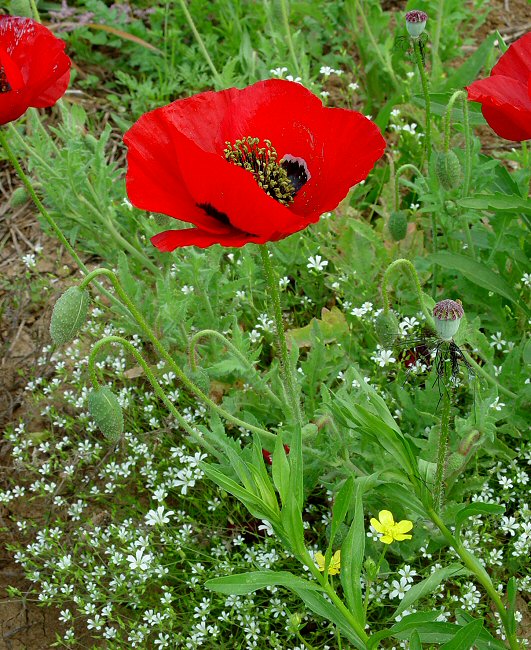Papaver rhoeas L.
Corn Poppy

Introduced
CC = *
CW = 5
MOC = 10
© DETenaglia
Papaver rhoeas L.Corn Poppy | |
 |
Introduced CC = * CW = 5 MOC = 10 |
© DETenaglia |
|
Family - Papaveraceae Stems - From a big taproot, with white to yellow milky sap, multiple from the base, erect, herbaceous, branching, terete, typically green with some purple at the base, to +/-50cm tall, hispid (the hairs with pustulate bases), scabrous.
Leaves - Alternate, petiolate below, sessile above, pinnately divided. Petioles of the lower leaves to +5cm long, with a deep "U"-shaped adaxial groove (the groove formed by decurrent leaf tissue). Upper leaves sessile. All leaves with the divisions serrate, acute, hispid on both surfaces, to +1cm broad, serrate. Serrations of the leaves with spine tips to 2mm long. The terminal division larger than the lateral divisions. Rachis of the leaves scabrous and hispid.
Inflorescence - Single long-pedunculate flowers from the upper leaf axils. Peduncles to +30cm long, terete, hispid, scabrous, erect. Flowers - Petals 4-6, scarlet with a white to typically black splotch at the base, glabrous, reniform to broadly obovate, to 5cm long, 8cm broad. Stamens many, from below and exceeding the pistil, ascending. Filaments thin, black (purple at the base), glabrous, to 1.7cm long. Anthers yellow-brown, +/-2mm long, +1mm broad. Ovary green, glaucous, obconic, glabrous, about 1cm long, +/-7mm in diameter in flower, quickly expanding in fruit. Stigma capitate, brownish-red, as many as the carpels and variable, radiating from the center as the spokes in a wheel. Sepals 2, caducous, 3cm long, elliptic, densely papillose-hispid (the hairs reddish and antrorse), glabrous internally, with a nipple-like apex.
Flowering - May - October. Habitat - Cultivated and escaped to fields, roadsides, and waste ground. Also planted along roadsides. Origin - Native to Europe. Other info. - This attractive species can be found scattered throughout Missouri but is fairly uncommon in the wild. There are a few different red-flowered species of poppy which are cultivated and the differences between them are usually fairly minute. P. rhoeas is the most common of these species. Photographs taken off Interstate 24 outside of Chattanooga, TN., 5-10-04. |